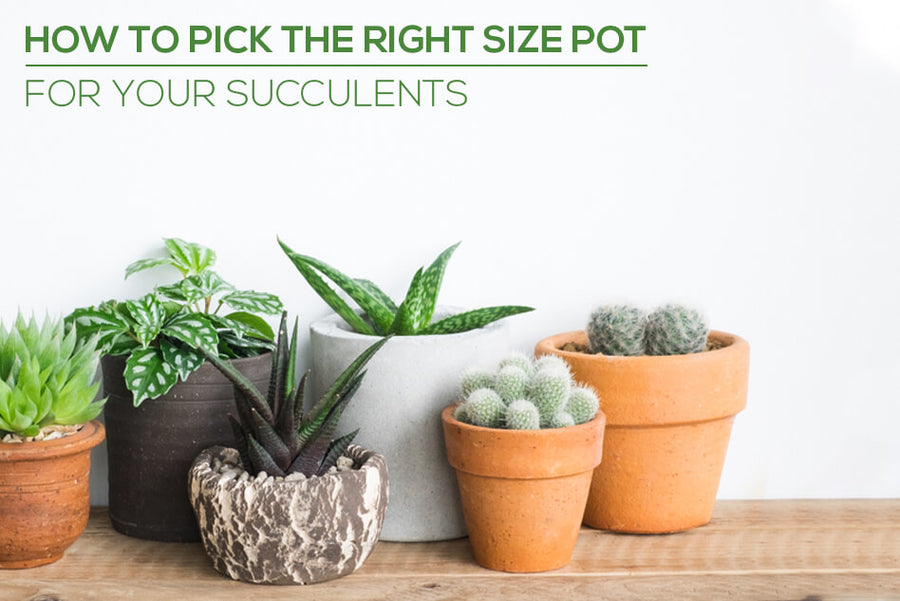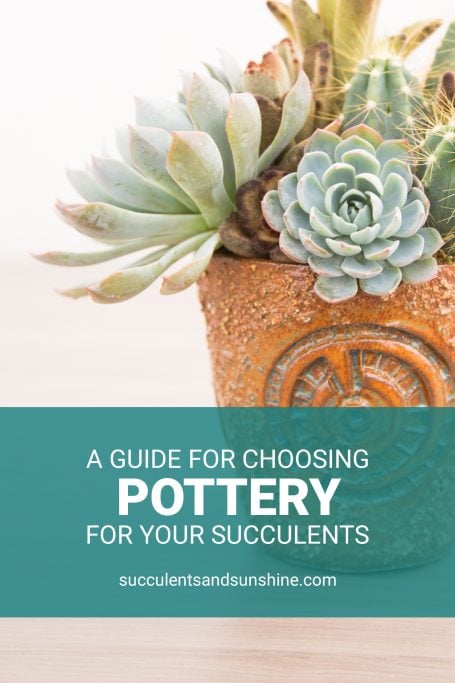Choosing the right pot or container for your succulents is essential for ensuring they remain healthy and create a stunning display.
When you buy products through links on this website, we may receive a commission, but it will not affect the cost you pay. This helps us to generate free materials that you can benefit from.
I’m obsessed with succulents and love picking out the perfect pottery to go with them. My favorite are the gorgeous teal blue pots, and my dream is to one day have a pair of them on my porch filled with vibrant orange succulents. It’ll be a sight to behold!
I adore searching for pottery and planters specifically designed for succulents, but it can be a difficult process to find the ideal one. From my experience, there are some essential features to take into account when selecting the right pot that many novice succulent growers overlook.
These elements can be essential in ensuring the health and prosperity of your succulents.
To make things even easier for you, I have created a free downloadable guide that shows you exactly what to look for when deciding if your succulents need more or less water. Click on this link to get it now, it will be very useful.
Table of Contents
Drainage!
If you have already read my posts on watering and soil, you probably know that I recommend to always choose a pot with a drainage hole. If nothing else, make sure that your pot has a drainage hole!
It’s a game-changer! Watering succulents is much simpler when you take the guesswork out of it – it will definitely make your life easier.
If you have a container you really like that doesn’t have a hole for draining, you can still use it. You can add drainage by drilling a hole with a diamond tip drill bit.
I adore Susan Aach’s pottery, such as the one depicted above, due to the large drainage holes included in each piece. These pots are tailored to be used with succulents, adding to the appeal.
Snappy Pots are an ideal choice for succulents, as they are designed with drainage holes and come with decorative accents you can use to diversify your succulent display.
You can use mesh tape or mesh screens to patch up the holes in the soil, preventing it from spilling out while still allowing the water to pass through.
As you become more familiar with taking care of succulents in a pot with a drainage hole, you can experiment with other types of pots. However, if you are just starting out, having a drainage hole would make the job simpler.
Material
pots are a great choice for plants.
Terra Cotta or Ceramic containers make excellent vessels for nurturing plants.
Terra cotta and ceramic are both good choices for places that don’t get much ventilation, both indoors and outdoors. They are both permeable materials, making them ideal for areas with limited air circulation.
In direct sunlight, a terra cotta or ceramic pot can become hot to the touch, which can be detrimental to succulents. However, this is usually not a major issue. Keep in mind that the soil in these pots will dry out more quickly if placed in direct sunlight.
The weight of terra cotta and ceramic pots can be a major challenge when gardening. Large pots are especially difficult to maneuver, both before and after being filled with soil and succulents.
These kinds of pots are delicate, so you should handle them with caution and be careful not to let them slip or fall.
waste is a major environmental issue
Plastic pollution is a major ecological problem.
Plastic containers and planters are a great option due to their relatively low weight and increased durability compared to ceramic. However, they are not as porous as terra cotta or ceramic, which means that water cannot evaporate as easily out of plastic containers, making them less breathable.
If you make sure to use soil that drains easily and create a drainage hole in your plastic pot, it shouldn’t be a problem that they are not breathable. Plus, the great thing about plastic planters is that they come in lots of different colors and shapes, making them really enjoyable to choose from.
is a material that is used to create structures and other objects.
Wood is employed for the construction of structures and making of items.
If you’re looking for a unique way to showcase your succulents, you may want to consider a wooden planter. I personally made a driftwood planter last summer and thought it was much more aesthetically pleasing than a traditional pot or planter.
Additionally, wood is advantageous for succulents that are exposed to direct sunlight or hot climates because it remains cool and holds moisture.
In contrast, if you’re planting in an area with limited sunlight and airflow, you may find that wood can quickly rot or retain too much moisture in the soil. Furthermore, the wood may decompose over time, or crack due to being constantly exposed to water.
In conclusion, although wood has a shorter lifespan than other materials for pots, if placed in the right spot, it can be a stunning addition to any garden.
that has been melted down
Reworded: Molten metal
Metal is not recommended for planting succulents in the long run, as it can become too hot due to its ability to adjust to temperature changes quickly.
Unless you use a metal pot specifically designed for planting, it will eventually rust, which could harm your succulents. It’s recommended to move your succulents to a new pot if you choose to use a metal container.
es allow people to see better
Reformulated: Spectacles enable individuals to have improved vision.
It is undeniable that glass is a visually pleasing material to display succulents in. However, it is important to note that most glass containers do not have drainage holes, with the exception of the wine bottle planter.
Glass containers can be problematic for growing because not only do they have drainage issues, but they also don’t allow for much air circulation, making it difficult for the soil to dry out unless the pot has a wide opening to allow air to flow freely.
Glass gets easily dirty and tends to accumulate hard water spots. It is also very fragile and must be handled with care, especially if you have children in the house.
Colors and Textures
Now that you understand the material that is best for your succulent planter, it’s time to have some fun! You can go about this in two different ways: either choose a pot based on the succulents you plan to use or decide on the succulents to use based on the pot you have chosen.
Cindy Davison from The Succulent Perch has mastered the art of matching succulents with the perfect pot. She carefully selects plants with colors that will either match or bring out the beauty of the pot.
In this example, she has coordinated the succulents with the design of the pot to create a cohesive and attractive display. The succulents are in colors and shapes that complement the pattern of the pot.
If you’re finding it difficult to choose the right planter for your succulents, don’t stress too much! A good go-to option is to use basic terra cotta or plain white pottery.
It appears that these containers bring out the best in succulents, emphasizing their beauty while keeping the focus on the plants themselves.
I’ve compiled a selection of Susan Aach’s wonderful ceramic artwork that is perfect for displaying succulents. Her pieces are always inspired by succulents and are certain to bring a beautiful touch to your home. Here are some of my favorite pieces from her shop on Etsy.
Cindy Davison from The Succulent Perch put together the display in a pot made by Susan Aach.
Size considerations
Figuring out the right size pot for your succulents and arrangements can be tricky. To ensure they have enough room to thrive, it’s best to make sure there’s a half-inch gap between the edge of the pot and the succulents. That way, they can have some room to expand.
If your succulent is small, it’s best to buy a pot that is slightly larger than the size of the succulent. This will prevent the roots from spreading out too quickly and not giving the succulent enough time to grow to its full potential. A 2.5 inch pot is generally a good size for a two-inch succulent.
If you’re creating a succulent arrangement, it’s important to leave some space between each plant so they have the opportunity to grow and thrive.
A closely arranged design such as the one below will be aesthetically pleasing once completed, and it typically inhibits the succulents from expanding too much.
If you desire for your succulents to expand and spread, provide them with some space for additional growth. It is recommended to leave at least half an inch to an inch of space to enable more growth.
Now that you’ve become more familiar with the considerations when buying a pot for your succulents, it can be an enjoyable process. There are lots of options to weigh, but it can be exciting to find the perfect pot to show off your succulent plants.
Once you’ve chosen the ideal pot, it’s time to begin planting! Have a look at my guide on planting succulents for a comprehensive guide.
Don’t forget to grab my helpful cheat sheet so you can tell when your succulents need more or less water. Click the link to get it – it’s totally free.
FAQ
Do succulents need rocks in bottom of pot?
The main goal of adding pebbles to the pot of a succulent plant is to improve drainage. This is due to the fact that succulents and cacti thrive in sandy soils that drain quickly, which prevents their roots from sitting in water for too long and becoming rotten. The pebbles act as a conduit for water to flow through the soil and away from the roots.
Are plastic pots bad for succulents?
Although plastic planters lack breathability, making water drainage a potential problem, it is advisable to purchase plastic pots with drainage holes and use the appropriate soil mixture for succulents to make sure the water does not remain pooled for an extended period around the roots.
Are clay pots OK for succulents?
These qualities make it an ideal container to grow succulents in. Small ceramic pots can be hung or placed in shady areas which provide the right amount of light and heat for the succulents.
Do succulents do better in clay or plastic pots?
Terracotta is an ideal choice for succulent pots, both inside and outdoors, due to its breathable material and its ability to absorb heat, providing the plants with the perfect environment to grow. If you want to explore other options, pottery planters may be a great alternative.


